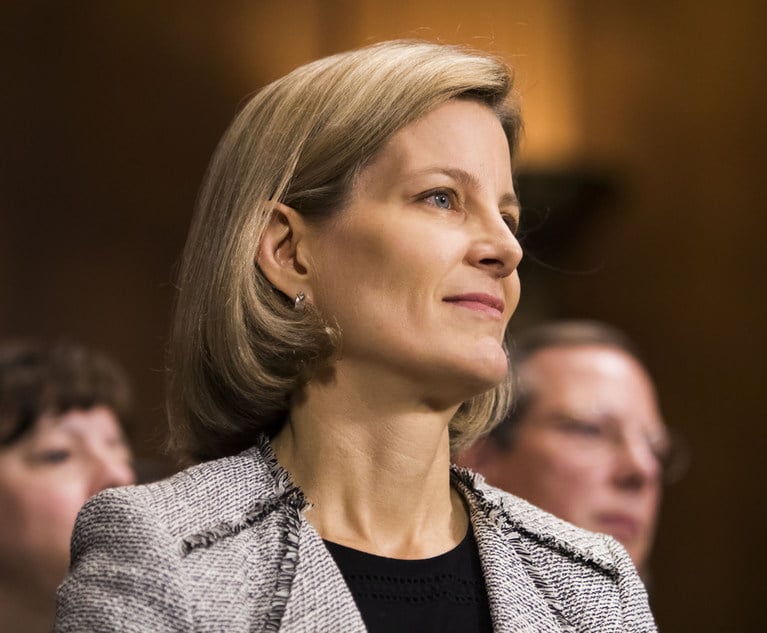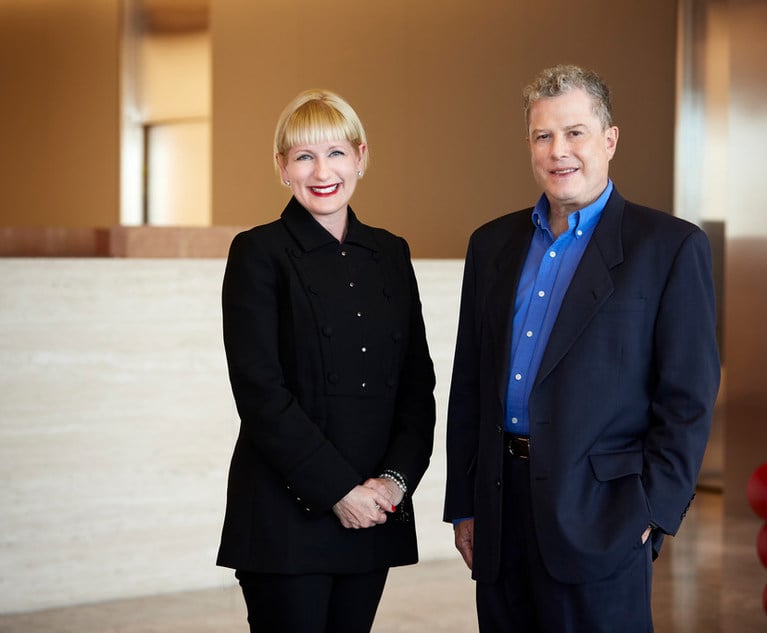Latham Blocks Patent Attack on $2 Billion-a-Year Blood Cancer Drug
MorphoSys and Kirkland & Ellis had accused a Janssen Pharmaceuticals biologic of infringing, but Judge Leonard Stark ruled MorphoSys' patents invalid for lack of enablement.
January 28, 2019 at 11:00 PM
3 minute read
 Michael Morin, Latham & Watkins (courtesy photo)
Michael Morin, Latham & Watkins (courtesy photo)
A team of Latham & Watkins attorneys has invalidated patents that threatened Janssen Biotech Inc.'s lucrative Darzalex blood cancer biologic drug. And they did it by using a lot of patentee MorphoSys AG's own expert testimony.
U.S. District Judge Leonard Stark of Delaware ruled Friday that MorphoSys' three patents on an antibody that binds to a protein known as CD38 are invalid for lack of enablement. The patents describe too many potential antibodies—potentially a quintillion, or 10 to the 19th power, according to Janssen. Although MorphoSys disputed that number, it conceded it could be in the billions, and Stark concluded that narrowing them down to the effective cancer killers would require undue experimentation.
“Three of MorphoSys' experts characterized screening techniques as 'extremely laborious [and] involving trial-and-error experimentation,' and exhibiting 'a lot of variability,' 'tak[ing] a while to get them up and running,' such as 'a period of months' or 'longer,'” Stark wrote in his order, which was unsealed Monday.
Essentially, the patents put a person of skill in the art at a starting point for further research, and that's not specific enough to satisfy the enablement requirement, Stark ruled.
The decision stems from a high-speed race between two European biotech companies to treat multiple myeloma. Germany's MorphoSys was first to the patent office, but Denmark's Genmab AG was first to market, partnering with Johnson & Johnson subsidiary Janssen to launch Darzalex in 2015.
Last year Darzalex rang up sales of $2 billion, and Fierce Pharma projects the figure to reach $5 billion by 2022. MorphoSys' stock price dropped 6.5 percent Monday following news of Stark's ruling.
Darzalex works by binding to the CD38 protein, destroying cancerous blood cells without triggering an immune response.
Backed by Kirkland & Ellis, MorphoSys sued Janssen and Genmab in 2016 in Delaware federal court. MorphoSys' patents describe types of antibodies and specific characteristics, such as which region of the CD38 protein they bind with, and includes a handful of representative examples. The description covered the active ingredient in Darzalex, MorphoSys charged.
Janssen argued that MorphoSys' description described a quintillion antibodies—more than every grain of sand on earth, Latham partner Michael Morin argued to Stark at a November hearing. MorphoSys disputed that figure, but its own expert conceded that the number would be in the millions or even billions, Stark noted in his order. And the active ingredient in Darzalex is only 35 percent similar to the most similar example actually disclosed in MorphoSys' patents.
“While not undisputed, any reasonable factfinder would conclude that a [person of skill in the art] would require substantial time and effort to discover antibodies” such as Darzalex, Stark concluded.
Latham's team was led by Morin and partners David Frazier, Roger Chin, Max Grant and Ann Marie Wahls, plus associates Brenda Danek and Michael Seringhaus.
This content has been archived. It is available through our partners, LexisNexis® and Bloomberg Law.
To view this content, please continue to their sites.
Not a Lexis Subscriber?
Subscribe Now
Not a Bloomberg Law Subscriber?
Subscribe Now
NOT FOR REPRINT
© 2025 ALM Global, LLC, All Rights Reserved. Request academic re-use from www.copyright.com. All other uses, submit a request to [email protected]. For more information visit Asset & Logo Licensing.
You Might Like
View All
'Irreparable Harm'?: US Judge Denies Big Pharma Motion to Halt FDA-Approved Generic Drug
3 minute read
'Johns Hopkins Preyed on Black Women': Ben Crump Reps Henrietta Lacks Estate
3 minute read
Several Am Law 100 Firms Help Compliance Startup SingleFile Raise $6.5M

Jenner, Looking at 'Stretch' Goals, Reached Double-Digit Revenue and Profit Growth
5 minute readTrending Stories
- 1Investor Sues in New York to Block $175M Bitcoin Merger
- 2Landlord Must Pay Prevailing Tenants' $21K Attorney Fees in Commercial Lease Dispute, Appellate Court Rules
- 3Compliance with EU AI Act Lags Behind As First Provisions Take Effect
- 4NJ's Pardons and Commutations A Model for the Federal System
- 5As Political Retribution Intensifies, Look to Navalny's Lawyers
Who Got The Work
J. Brugh Lower of Gibbons has entered an appearance for industrial equipment supplier Devco Corporation in a pending trademark infringement lawsuit. The suit, accusing the defendant of selling knock-off Graco products, was filed Dec. 18 in New Jersey District Court by Rivkin Radler on behalf of Graco Inc. and Graco Minnesota. The case, assigned to U.S. District Judge Zahid N. Quraishi, is 3:24-cv-11294, Graco Inc. et al v. Devco Corporation.
Who Got The Work
Rebecca Maller-Stein and Kent A. Yalowitz of Arnold & Porter Kaye Scholer have entered their appearances for Hanaco Venture Capital and its executives, Lior Prosor and David Frankel, in a pending securities lawsuit. The action, filed on Dec. 24 in New York Southern District Court by Zell, Aron & Co. on behalf of Goldeneye Advisors, accuses the defendants of negligently and fraudulently managing the plaintiff's $1 million investment. The case, assigned to U.S. District Judge Vernon S. Broderick, is 1:24-cv-09918, Goldeneye Advisors, LLC v. Hanaco Venture Capital, Ltd. et al.
Who Got The Work
Attorneys from A&O Shearman has stepped in as defense counsel for Toronto-Dominion Bank and other defendants in a pending securities class action. The suit, filed Dec. 11 in New York Southern District Court by Bleichmar Fonti & Auld, accuses the defendants of concealing the bank's 'pervasive' deficiencies in regards to its compliance with the Bank Secrecy Act and the quality of its anti-money laundering controls. The case, assigned to U.S. District Judge Arun Subramanian, is 1:24-cv-09445, Gonzalez v. The Toronto-Dominion Bank et al.
Who Got The Work
Crown Castle International, a Pennsylvania company providing shared communications infrastructure, has turned to Luke D. Wolf of Gordon Rees Scully Mansukhani to fend off a pending breach-of-contract lawsuit. The court action, filed Nov. 25 in Michigan Eastern District Court by Hooper Hathaway PC on behalf of The Town Residences LLC, accuses Crown Castle of failing to transfer approximately $30,000 in utility payments from T-Mobile in breach of a roof-top lease and assignment agreement. The case, assigned to U.S. District Judge Susan K. Declercq, is 2:24-cv-13131, The Town Residences LLC v. T-Mobile US, Inc. et al.
Who Got The Work
Wilfred P. Coronato and Daniel M. Schwartz of McCarter & English have stepped in as defense counsel to Electrolux Home Products Inc. in a pending product liability lawsuit. The court action, filed Nov. 26 in New York Eastern District Court by Poulos Lopiccolo PC and Nagel Rice LLP on behalf of David Stern, alleges that the defendant's refrigerators’ drawers and shelving repeatedly break and fall apart within months after purchase. The case, assigned to U.S. District Judge Joan M. Azrack, is 2:24-cv-08204, Stern v. Electrolux Home Products, Inc.
Featured Firms
Law Offices of Gary Martin Hays & Associates, P.C.
(470) 294-1674
Law Offices of Mark E. Salomone
(857) 444-6468
Smith & Hassler
(713) 739-1250








